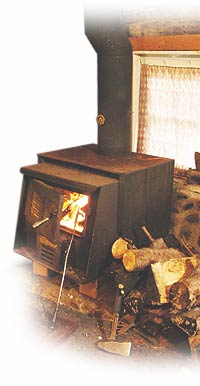Wood Stoves
Wood fireplaces are space-heating systems that heat the area they are located. The internal design of wood stoves has changed entirely in the past 15 years, as the result of the U.S. Environmental Protection Agency regulation established in the late 1980s. The EPA's mandatory smoke emission limit for wood stoves is 7.5 grams of smoke per hour. Today, all wood stoves and fireplace inserts, and some factory-built fireplaces sold in the U.S. must meet this limit. Stove manufacturers have improved their combustion technologies over the years, and now some newer stoves have certified emissions in the 1 to 4 gram per hour range. The EPA certified emission rate is a reliable number that can be compared from one model to the next, but a one or two gram per hour difference in smoke emissions does not mean much in day-to-day use. Wood stoves are divided into three categories Catalytic, Non-Catalytic, and pellet. These types of stoves come in freestanding types or as inserts that can be placed in an existing chimney firebox.
Catalytic
Catalytic wood stoves are generally associated with the burning of round wood, but waste wood can also be used. In catalytic combustion the smoky exhaust is passed through a coated ceramic honeycomb inside the stove where the smoke gases and particles ignite and burn. Catalytic stoves are capable of producing a long, even heat output. All catalytic stoves have a lever-operated catalyst bypass damper, which is opened for starting and reloading. The catalytic honeycomb degrades over time and must be replaced, but its durability is largely in the hands of the stove user. The catalyst can last more than six seasons if the stove is used properly, but if the stove is over-fired, garbage is burned and regular cleaning and maintenance are not done, the catalyst may break down in as little as two years .
Non-Catalytic
Non-catalytic wood stoves are associated with the burning of round wood, but waste wood can also be used. Non-catalytic stoves do not use a catalyst, but have three internal characteristics that create a good environment for complete combustion. These are firebox insulation, a large baffle to produce a longer, hotter gas flow path and pre-heated combustion air introduced through small holes above the fuel in the firebox. Secondary air or secondary combustion is achieved by injecting oxygen into the hot gases (smoke) and burns it before it leaves the stove. The baffle and some other internal parts of a non-catalytic stove will need replacement from time to time as they deteriorate with the high heat of efficient combustion.
Pellet Stoves
Pellet stoves burn "pellets." These pellets are recycled sawdust, wood shavings, corn, walnut and peanut shells, and similar biomass wastes that are ground up, compressed and extruded. The 3/8-inch to 1-inch-long pellets look like rabbit feed, and they are sold in 40-pound bags . Some pellet stoves are also designed to burn corn kernels, nutshells, and wood chips. They use a forced-air system to distribute heat. Pellet-burning appliances are highly efficient and pollute very little. Pellet stoves produce virtually no smoke, and produce fewer odors than other wood-burning appliances. Moreover, the exteriors of these appliances are not used for radiating heat and stay relatively cool, preventing you from burning yourself if you accidentally touch the stove.
Pellet stoves have not been sold in Alaska to a large degree due the fact that the fuel required ‘pellets’ have not be manufactured locally with the exception of in Delta Junction.
The Pellet Fuels Institute is an industry association with information on pellet fuel and pellet stoves.
Wood Stove Producers
The outlined woodstove companies below produce a combination of catalytic, non-catalytic and pellet stoves. UAF/CES does not endorse any of the following companies. It is the author’s intent to only inform the public about different companies that produce different types of stoves.
|
Alaska Company, Inc. Alternative Heating American Energy Systems Blaze King Breckwell Pellet Stoves Country Flame Technologies Drolet Harman Stove Company |
Hearthstone Jotul Lennox Hearth Products Napoleon Fireplaces Osburn Stoves RIAS Regency Fireplace Products Travis Industries, Inc. Vermont Castings, Incorporated |

